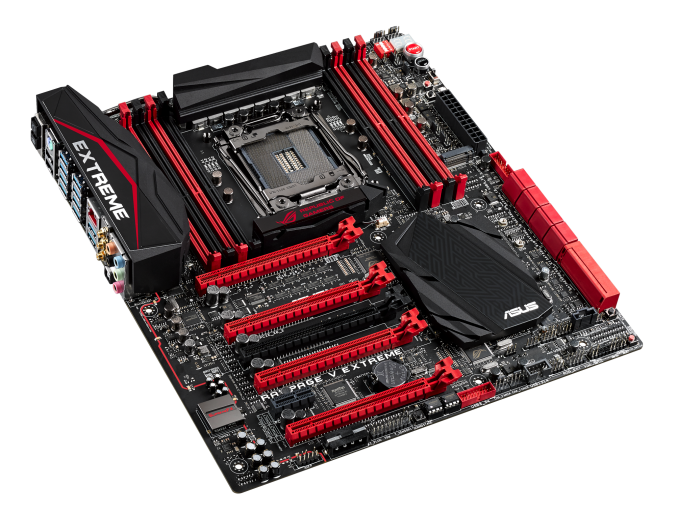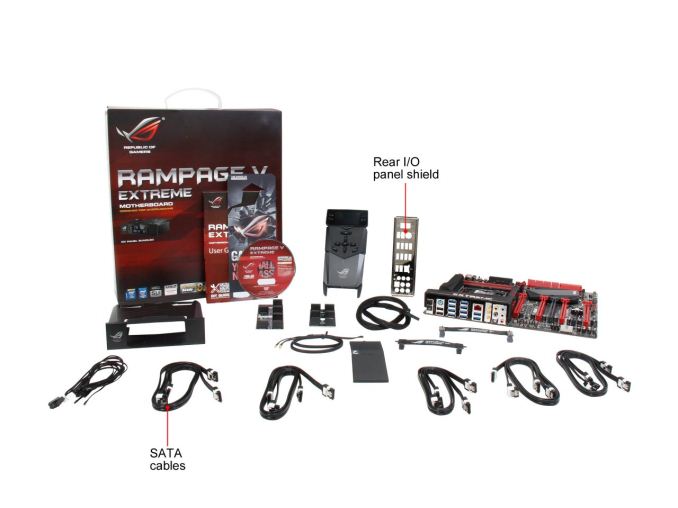The ASUS X99 Rampage V Extreme ROG Review
by Ian Cutress on June 22, 2015 8:45 AM EST- Posted in
- Motherboards
- Asus
- ROG
- Haswell-E
- X99
Conclusion
Having used the last two Extreme versions of the top of the ROG line, the Rampage IV Extreme and the Rampage IV Black Edition, it subsequently occurs perhaps the Rampage V Extreme comes across as a little underwhelming. If you've been there, seen that, it's hard to get as pumped up as the first time. The Extreme is a very good motherboard, and comes across as well engineered and with some fun stuff to play with that new users will enjoy. If you were happy with the X79 Extreme and need a comparable hardware option for X99 then the Extreme is ready to take that place. My fear is that it the Rampage V Extreme isn't as breathtaking as the X79 was.
The measure of breathtaking-ness isn't the defining feature of a motherboard however. In terms of kit we get ASUS' enhanced OC socket at the front and center, which reportedly gives better overclocking margins as well as high end memory support which we covered in our initial X99 coverage as it also featured on the X99 Deluxe. Another big feature is the use of three-stream dual band 802.11ac Wi-Fi which will aid throughput and beam forming for routers that are capable. ASUS is using tri-stream as a defining feature on the top end of its product stack, which means it is also on the Deluxe as well. To complete the trifecta, the OC Panel allows gamers to get hardware information and implement fan controls at the touch of a button while extreme overclockers can adjust voltages and frequencies on the fly.
Other features in play include eight fan headers with DC and PWM support, with four extra headers on the OC Panel, SupremeFX audio via an upgraded ALC1150 solution (PCB separation, extended EMI shield, upgraded filter caps, headphone impedance detection) as well as SoundStage and Keybot. Storage comes from the 10 SATA ports provided by the chipset as well as two more from an ASMedia controller and two SATA Express ports therein. An M.2 PCIe 3.0 x4 slot is also here for 2260, 2280 and 22110 drives, but shares bandwidth with the bottom PCIe 3.0 port in red. This has implications when multiple graphics cards are in play and SLI limitations, but the subset of M.2 users and 4-way SLI users should actually be fairly small. A total of 14 USB 3.0 ports populate the board, two from headers and ten on the rear panel from ASMedia controllers/hubs.
The BIOS and Software packages from ASUS still continue to be on the better side of interactive and informative, with the ROG packages aiming for something a little bit more than the standard. Due to the overclocking nature of the Extreme, there is the potential to get bogged down in all the overclocking options for new users. To this end there are several automatic overclocking options, both in the BIOS and software, as well as assistance through the ROG forums. Our overclocking performance showed that a mediocre CPU is still a mediocre CPU, whichever way you slice it, but good luck to those who scored nice silicon. We’ve tested the X99 Extreme up to DDR4-3333 on the latest BIOS as of testing, although our contacts at ASUS have stated that they are working on the new higher-end kits (3400 and up) to add to the QVL.
Whatever the X-Factor (or Y-Factor, or Z-Factor) is, I’m not getting the same feeling as I did from the X79 Extreme. In the words of James May of ex-Top Gear fame, there’s no fizzing root here. Part of that may be the saturation of high-end boards in the market, always going for halo, or the lack of a 4.7+ GHz overclocking CPU architecture when testing as was the case with Sandy Bridge-E and X79, but I’m not sure. It will be interesting to see the sales numbers this time around, and whether ASUS can hold that high end lead. Overall, the Rampage V Extreme continues the trend of the ROG Extreme halo series and builds on the nicely designed X99 Deluxe with an ROG garnish. For users looking for that direct, high-end upgrade from X58 or X79, it will have to be in the list for consideration.
It is also worth noting that since we received this sample, ASUS has released a USB 3.1 edition with a bundled USB 3.1 card in preparation for when the appropriate devices hit the market.












41 Comments
View All Comments
dark4181 - Monday, June 22, 2015 - link
No mention of NVMe support? EATX? Dealbreakers for me. I need ATX formfactor and NVMe support. Looks like I'm getting the X99-Pro/3.1freeskier93 - Monday, June 22, 2015 - link
Asus has already said all Z97 and X99 will have NVMe support, not sure why this would be an exception.SirGCal - Monday, June 22, 2015 - link
Surprised they don't have USB C in there also. Everything else but missing out on the super fast and flexible new USB support. I'll wait some more. And ya, no EATX For me either anymore...BPB - Monday, June 22, 2015 - link
The article states there is a version with USB 3.1DanNeely - Monday, June 22, 2015 - link
It's USB3.1 but still A style connectors, not the new C one. The addin board providing it is PCIe x4; so you're giving up a 4way GPU setup to use it. A minor concern for most people, but it goes toward the existing you can have it all but not all at once problem the board has.BPB - Monday, June 22, 2015 - link
Good points. I don't see a need for the new connector for a while, but I think Asus should have included it.Breit - Tuesday, June 23, 2015 - link
You know this board was released back in august 2014, right?movieman03 - Monday, June 22, 2015 - link
I think they had to go EATX to fit all the PCI-e slots and a full size M.2. There is just a lot going on. I have the Z97 Maximus VII forumula and ASUS gave us a little riser card that limits the physical size of the M.2, so it is nice to see them able to use the full size with this oneDanNeely - Monday, June 22, 2015 - link
"As with any purchase of a high end motherboard for gaming, taking it out of the box is an experience. Only a system builder that has to put together 50 systems a week would get bored of it."Seriously. I think the only time I was even vaguely excited about all the stuff bundled in with a board was 14 years ago when I built my first box. The last time I cared about a major chunk of the bundled stuff was 8 or 9 years ago when I build my first sata box and needed new cables. Now...
Looking at the bundle on Newegg my reactions are: Are those cables with LEDs on the end?!?! Even if I had a case with a Window and wanted to bling my system out in the tackiest gamer style *gag*, those probably wouldn't be the right colors for what I wanted. I've got probably 10 sata cables for every sata drive I own at this point; that's the last thing I need now. Ditto for the collection of SLI bridges. I'll be OCing this box once when I first build it, after that point that OC handset thingy will be totally worthless; and even then sitting on the table is fine I don't need a stand for it. On the plus side, no USB/firewire bracket. On the minus side, it looks like they're missing the one useful bit of the bundle: the little header blocks that let you bundle all the front panel connectors into a single block where you can see what you're doing before plugging them in. (The fact that virtually everyone is using a decade+ old standard for how the headers are laid out; but no case vendor is willing to put them into a unified block continues to enrage me every time I build a new system.)
Schickenipple - Monday, June 22, 2015 - link
I'll second that comment about the switch/LED header blocks. I can't believe it's not a standard by now!